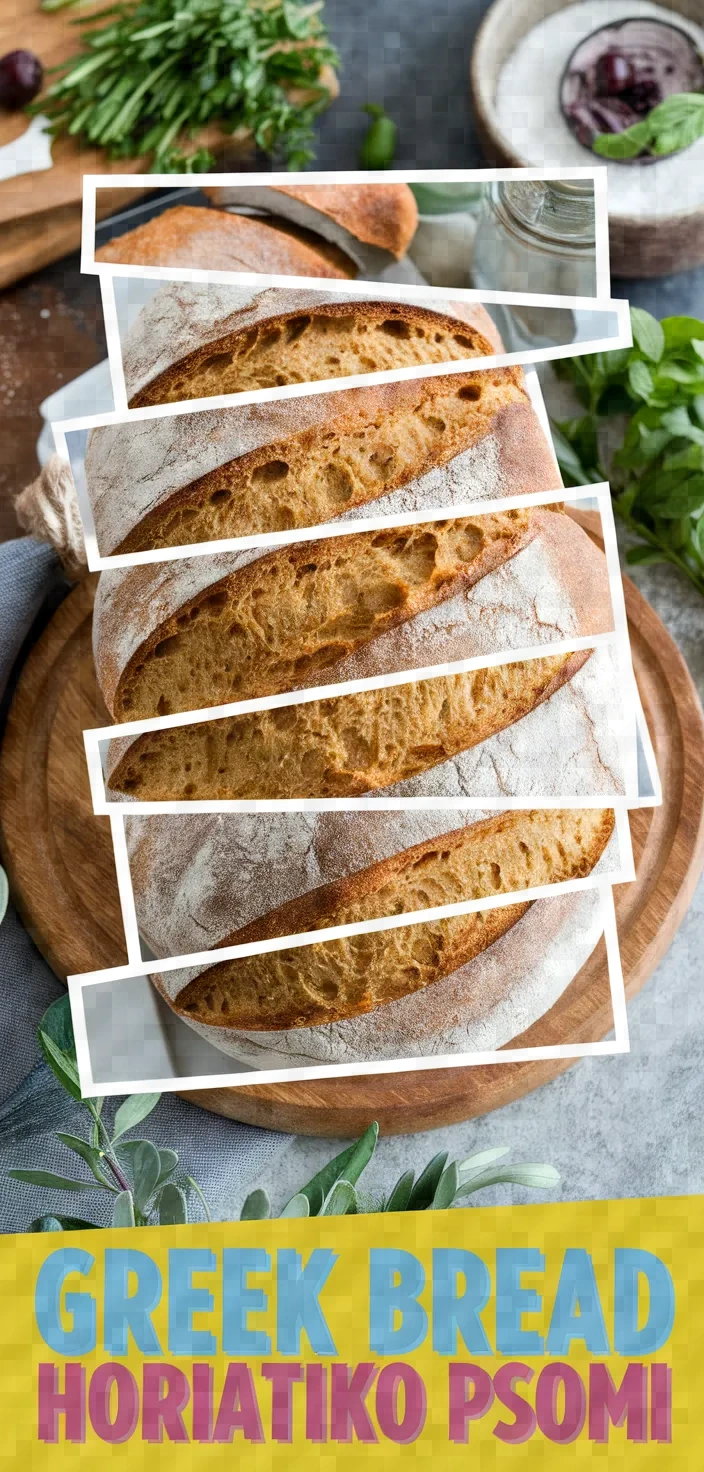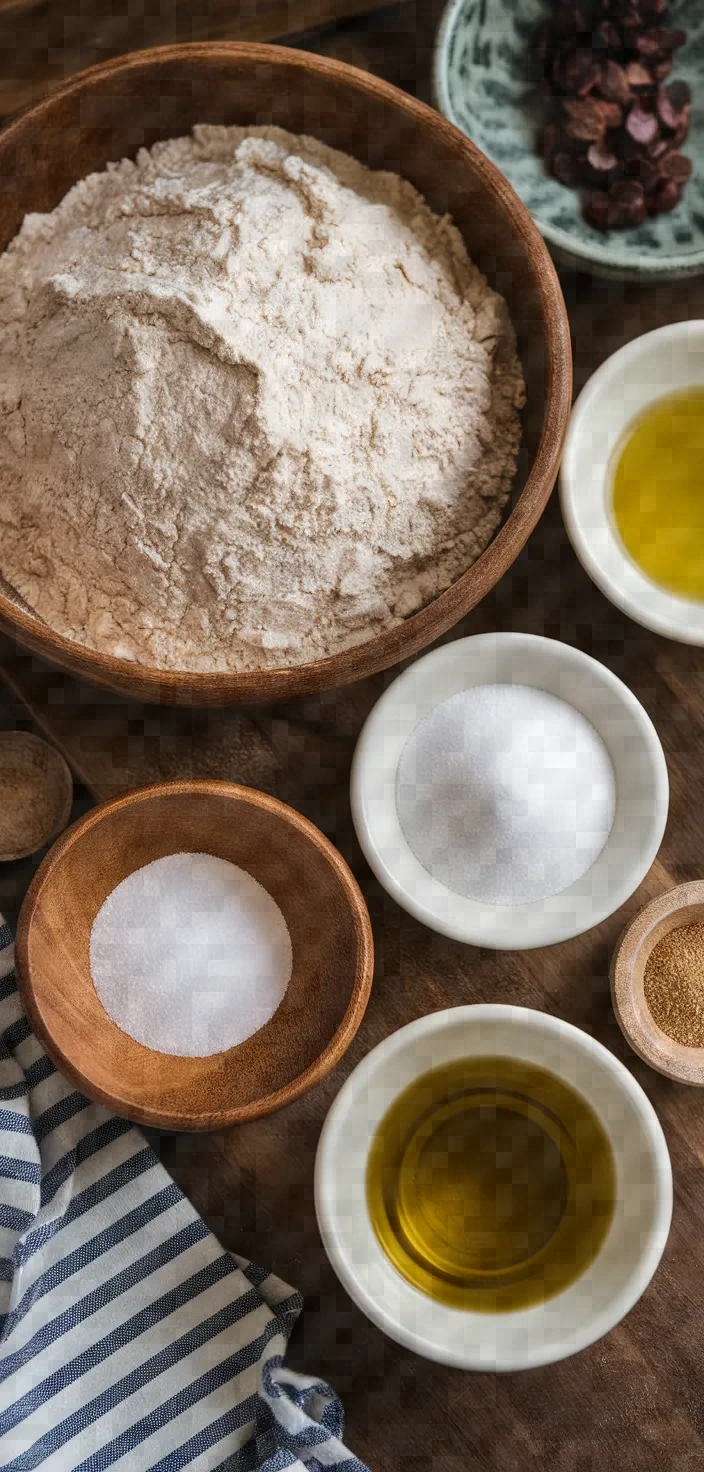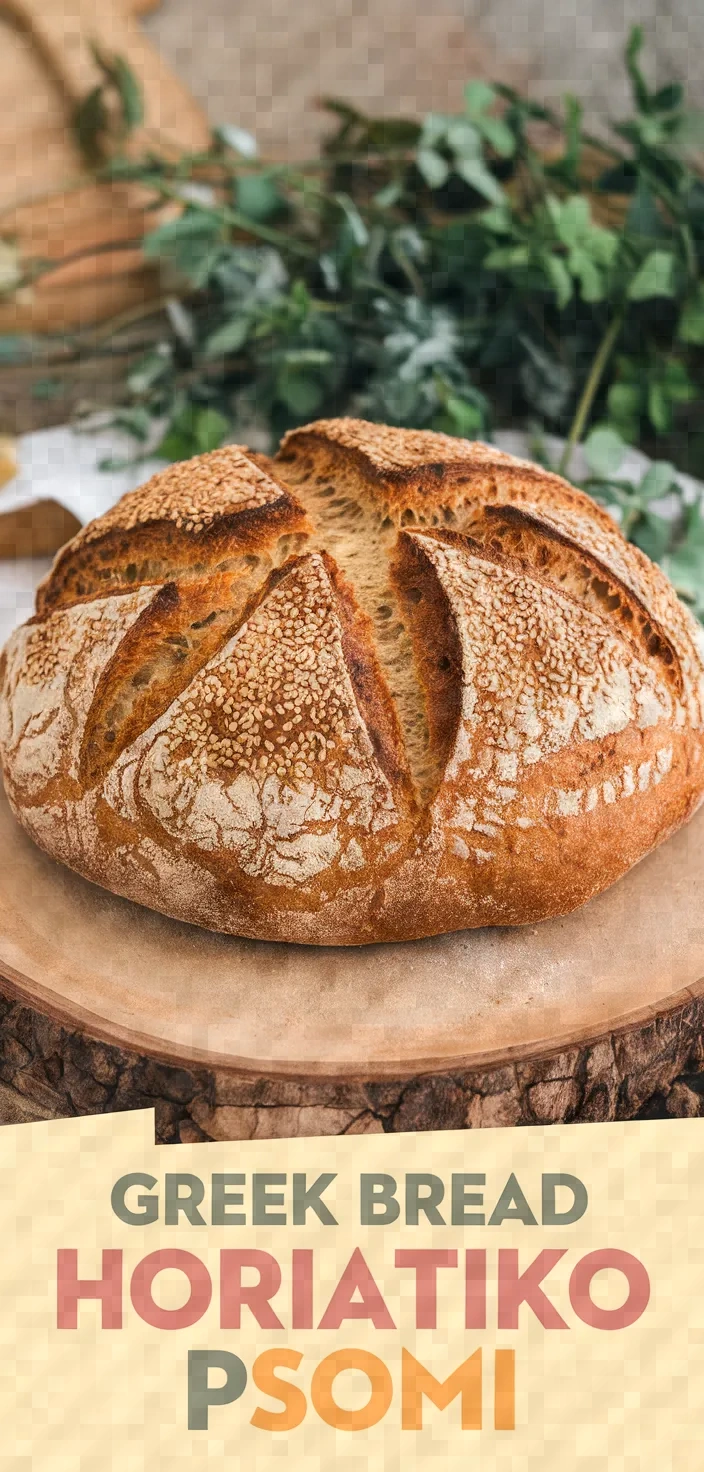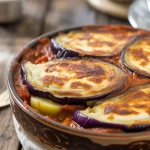There’s truly nothing quite like the satisfaction of baking your own bread from scratch, feeling the warmth of the kitchen with the aroma of home-cooked goodness wafting through the air. This recipe for a classic round loaf delivers a rustic charm and a supremely satisfying crunch that’s perfect for any meal or snack.

I enjoy baking Horiatiko Psomi, a traditional Greek bread. Its country-style crust and slightly chewy texture come from using all-purpose flour.
The flavor of the bread is enriched by a generous amount of olive oil. I love to watch the dough rise with the help of warm water that activates the yeast, a bit of sugar, and a touch of salt.
The bread is as healthy as it is delicious.
Greek Bread Horiatiko Psomi Recipe Ingredients

- All-purpose flour: Provides structure; rich in carbohydrates; moderate protein content.
- Salt: Enhances flavor; crucial for gluten strength and yeast control.
- Sugar: Feeds yeast; adds slight sweetness; aids in fermentation.
- Dried yeast: Leavening agent; essential for dough rising; enhances bread texture.
- Olive oil: Adds moisture; tenderizes dough; contributes healthy fats and flavor.
Greek Bread Horiatiko Psomi Recipe Ingredient Quantities
- 4 cups all-purpose flour
- 1 1/2 teaspoons salt
- 1 tablespoon sugar
- 1 tablespoon dried yeast
- 1 1/2 cups warm water (about 110°F/45°C)
- 2 tablespoons olive oil
How to Make this Greek Bread Horiatiko Psomi Recipe
1. In a big bowl, mix the yeast, sugar, and warm water. Give it a good stir, then let it sit for 5-10 minutes until it becomes nice and foamy. That’s the look you’re going for!
2. Combine the yeast mixture with the olive oil by stirring.
3. In another bowl, combine the flour and salt.
4. Slowly incorporate the flour blend into the mixture of liquids, using a wooden spoon to stir until the mass starts to resemble a dough.
5. Move the dough to a surface that has been lightly sprinkled with flour. Knead it for about 10 minutes until the dough takes on a smooth, elastic quality and no longer sticks to your hands or the board.
6. Grease a large bowl with a thin layer of olive oil. Place the dough in the bowl, and cover it with a damp cloth or plastic wrap. Let it rise in a warm place for about 1-2 hours or until it has doubled in size.
7. Set your oven to the temperature of 375 degrees Fahrenheit (190 degrees Celsius).
8. Deflate the dough, then move it to a surface that is lightly dusted with flour. Form the dough into the shape of a round loaf.
9. Put the loaf on a baking sheet that is lined with parchment paper. Cover it with a towel and allow it to rest for another 30 minutes.
10. Preheat the oven to 375°F. Bake in the heated oven for 35 to 45 minutes, or until you tap the bottom of the bread and it sounds hollow. Let the bread cool before slicing.
Greek Bread Horiatiko Psomi Recipe Equipment Needed
1. Large mixing bowl
2. Medium mixing bowl
3. Wooden spoon
4. Measuring cups
5. Measuring spoons
6. Kitchen scale (optional, for more precise measurements)
7. Flat work surface (for kneading)
8. Baking sheet
9. Parchment paper
10. Clean kitchen towel or plastic wrap
11. Oven mitts
12. Cooling rack
FAQ
- What type of flour should I use for Horiatiko Psomi?Use all-purpose flour. It gives the bread a good structure and texture.
- Can I use fresh yeast instead of dried yeast?Fresh yeast can be used. Generally, you’ll require around 2 to 3 times the quantity of fresh yeast versus dried yeast.
- What is the ideal water temperature for activating the yeast?The proper activation of the yeast demands that the water be warm, around 110°F/45°C. If the water is not warm enough, the yeast will not ferment. If the water is too hot, the yeast will be killed.
- How long should I knead the dough?Work the dough by hand on a flat, clean surface, folding and pushing the dough until it forms a smooth, elastic ball. This takes some time—about 10 minutes is ideal.
- What is the best way to let the dough rise?Allow the dough to rise in a warm, draft-free part of your kitchen until it has grown to double its size. You can expect this to take 1 to 2 hours.
- Can I substitute olive oil with another type of oil?Although olive oil imparts an authentic flavor to the dish, you can use another vegetable oil if you need to.
Greek Bread Horiatiko Psomi Recipe Substitutions and Variations
All-purpose flour.
1. It is made from hard and soft wheat, milled to a fine powder.
2. The protein content, which can vary depending on the wheat and where it is grown, can be as low as 10.5 percent and as high as 14 percent.
3. The flour, laced with gluten, is what gives most baked goods their structure.
Flour from whole wheat (yielding a bread that is denser and more rustic in nature)
Flour for bread (to make it chewier)
Rephrase the following text while keeping the structure and formatting of the source material intact, including elements such as lists:
Salt:
Sea salt (for a finer grain and slightly different flavor)
Sugar is the common name for a sweet, soluble carbohydrate. In food, it provides sweetness and energy. The most common sugars are: – Sucrose, or table sugar, which comes mainly from sugarcane and sugar beets. – Glucose, or grape sugar, which comes from the breakdown of starch in the body and is also found in many fruits. – Fructose, or fruit sugar, which is found in honey and most fruits.
Honey (for a slight increase in moisture and a richer flavor)
Brown sugar (for a hint of molasses flavor)
Yeast, dried:
No need to dissolve in water first; can add directly to flour. Yeast, instant.
Newly harvested yeast (use about three times the weight)
Spanish olive oil is typically the world’s finest.
Olive oil by-products:
– Olive pomace oil
– Pure olive oil
– Semi-refined olive oil
Oil that comes from vegetables (for a flavor that’s not heavy)
Butter that has been melted (for a taste that is richer and a crumb that is softer)
Pro Tips
1. Proof the Yeast Properly Ensure the water used to mix with the yeast is at the correct temperature (about 110°F/45°C). Too hot can kill the yeast, while too cold can slow down its activity. The sugar in the recipe helps feed the yeast, aiding in the proofing process.
2. Use Fresh Yeast Check the expiration date on your yeast container before starting. Fresh yeast is crucial for a good rise and successful bread.
3. Consider Flavor Enhancements Add herbs like rosemary or thyme to the flour and salt mixture for added flavor, or incorporate roasted garlic or olives to give the bread a savory twist.
4. Kneading Technique When kneading, use the heel of your palm to push down and forward on the dough. Rotate it slightly with each push. This helps in developing the gluten, giving the bread its desired texture.
5. Optimize Baking Conditions For a better crust, place a shallow pan of water in the bottom of the oven during the first half of baking. The steam helps create a crispier crust on the finished loaf.

Greek Bread Horiatiko Psomi Recipe
My favorite Greek Bread Horiatiko Psomi Recipe
Equipment Needed:
1. Large mixing bowl
2. Medium mixing bowl
3. Wooden spoon
4. Measuring cups
5. Measuring spoons
6. Kitchen scale (optional, for more precise measurements)
7. Flat work surface (for kneading)
8. Baking sheet
9. Parchment paper
10. Clean kitchen towel or plastic wrap
11. Oven mitts
12. Cooling rack
Ingredients:
- 4 cups all-purpose flour
- 1 1/2 teaspoons salt
- 1 tablespoon sugar
- 1 tablespoon dried yeast
- 1 1/2 cups warm water (about 110°F/45°C)
- 2 tablespoons olive oil
Instructions:
1. In a big bowl, mix the yeast, sugar, and warm water. Give it a good stir, then let it sit for 5-10 minutes until it becomes nice and foamy. That’s the look you’re going for!
2. Combine the yeast mixture with the olive oil by stirring.
3. In another bowl, combine the flour and salt.
4. Slowly incorporate the flour blend into the mixture of liquids, using a wooden spoon to stir until the mass starts to resemble a dough.
5. Move the dough to a surface that has been lightly sprinkled with flour. Knead it for about 10 minutes until the dough takes on a smooth, elastic quality and no longer sticks to your hands or the board.
6. Grease a large bowl with a thin layer of olive oil. Place the dough in the bowl, and cover it with a damp cloth or plastic wrap. Let it rise in a warm place for about 1-2 hours or until it has doubled in size.
7. Set your oven to the temperature of 375 degrees Fahrenheit (190 degrees Celsius).
8. Deflate the dough, then move it to a surface that is lightly dusted with flour. Form the dough into the shape of a round loaf.
9. Put the loaf on a baking sheet that is lined with parchment paper. Cover it with a towel and allow it to rest for another 30 minutes.
10. Preheat the oven to 375°F. Bake in the heated oven for 35 to 45 minutes, or until you tap the bottom of the bread and it sounds hollow. Let the bread cool before slicing.

















